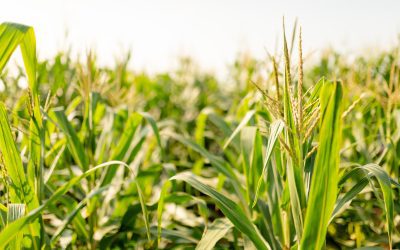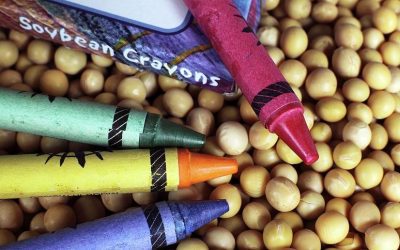BY DAVE BLOWER JR.
Among the primary missions of the Indiana Soybean Alliance (ISA) and the Indiana Corn Marketing Council (ICMC) is developing new markets. Among the most reliable markets for Indiana’s corn and soybean farmers is one of their oldest customers – the state’s pork and beef industry.

recently that livestock exports bring significant value to corn
and soybean farmers.
“The ISA and ICMC boards invest in projects that move the pile and bring a strong return on investment back to
Indiana corn and soybean farmers,” said Courtney Kingery, CEO for ICMC and ISA. “Livestock is the No. 1 customer for Indiana-grown corn and soybeans, and recent years have been record-setting for exports of U.S. pork and beef. This has provided a major benefit to Indiana’s corn and soybean growers.”
During the past three years, Indiana’s corn and soybean checkoff programs have invested $2.7 million to support U.S. meat promotion efforts in markets around the world. In 2022, Kingery said, the combined impact of meat exports to Hoosier soybean and corn farmers is valued at more than $340 million.
Corn and soybeans are an essential feed source for the state’s livestock.
The U.S. Meat Export Federation (USMEF) is one of the checkoffs’ vital partners in exporting soybeans and corn through red meat exports. In April, USMEF President and CEO Dan Halstrom, Senior Vice President of Industry Relations John Hinners and Director of Communications John Herath visited the ISA-ICMC office to explain their progress in improving the value of corn and soybean crops. The USMEF develops new global markets for U.S. beef, pork and lamb exports.

Nationally, in 2022 the market value of U.S. beef and pork exports to corn growers was $3.4 billion with more than 503.4 million bushels used. For soybean farmers, the 2022 market value of U.S. pork exports was $1.33 billion with more than 89.7 million bushels consumed. Hinners said livestock exports quickly add revenue to the bottom line of row-crop farmers. “Every time we export a ham, we export 15 pounds of soybean meal and more than 5 pounds of corn and DDGs,” he explained.
USMEF’s work is paid through a variety of sources including funds from the USDA’s Market Access Program (MAP), Foreign Market Development (FMD) and Emerging Market programs. In addition to membership dues and private contributions, USMEF also receives funding from beef, pork, lamb and corn and soybean checkoff programs.
“The competition in this world is real. Other countries can be aggressive,” said Hinners, who noted that Korea invested $14 million into a new beef export program. “When you have competition like that, you have to figure out how to ‘out-market’ them.”
Finding a competitive edge
Not every market is opened with the same strategy. Halstrom said some new customers are attracted by unique cuts of meat while others are encouraged by how U.S. farmers produce their crops and livestock.
“There is a lot of collaboration between Indiana agriculture and USMEF globally. We’re interested in meat exports and the largest customers of Indiana soybeans and corn is the livestock industry, so we gave an update on where we’re at globally on the trendline,” Halstrom said.
“On the beef side, we had a record in 2022. There was broad-based growth across a lot of markets, including places like China, Southeast Asia and Korea. On the pork side, we were down a little bit last year, mainly because of China, but 2022 was still the third-largest export year ever. Leading the way has been Latin America led by Mexico, Korea and Southeast Asia on the pork side. We’re off to a very good start for pork for 2023. Through the first two months we’re up about 8-9 percent and things are looking good going forward as well on the pork export front.”
Two ISA board members are on USMEF’s Executive Committee. They are Coatesville, Ind., farmer Mark Legan, who represents oilseed producers, and Flat Rock, Ind. farmer Jim Douglas, who is the United Soybean Board representative.
“We raise pigs,” said Legan, who also grows soybeans and corn. “In trying to move the entire carcass of the pigs, variety meats have added over $10 per head for every pig marketed in the U.S. and those are predominantly exported. On the grain side of our operation, meat exports bring a lot of value to Indiana grain farmers. If we didn’t have those exports, it would mean less money to Indiana grain farmers, and we would have a considerably smaller livestock footprint here in the state and U.S., as well.”
The “variety meats” that Legan mentioned are cuts of meat that are not commonly sold in the United States. These cuts add value to livestock without adversely affecting the cost of popular U.S. cuts.
“It’s about putting the right cut in the right market to maximize the value,” Haltstrom said. “It’s not about exporting more at the expense of the domestic market. It’s about finding that balance.”
“Japan, Korea and Mexico, our mainstay markets, will always be important, but we have a strategic focus on trying to grow some of the less developed countries around the world,” said Haltstrom, who cited Colombia in South America and The Philippines in Southeast Asia as examples. “We’re really excited about the prospects of some of these new markets hold in the near- to mid-term timeframe.”
Marketing the sustainability story
The USMEF executives claimed adopting popular sustainability practices helps secure export markets. “It’s a true marketing tool, today,” Halstrom said.
“One of the things that is really a buzz word in all of agriculture right now is sustainability, and Dan Halstrom reported that even some of our foreign customers are starting to ask about the carbon footprint of pork produced in the U.S. for example,” said Legan, adding that ramping up sustainability efforts gives U.S. producers a competitive advantage. “When we talk about sustainability, we don’t think about it going into export markets, but helping to differentiate our product from the Canadians or Europeans, for example, makes a difference.”
Hinners explained that some markets, like many European countries, find assurance in how U.S. farmers
produce crops and livestock. “We don’t market a lot of beef in Europe, but pound for pound, it is a very valuable market for U.S. beef,” he said.
Halstrom added, “Europe is one of the biggest naysayers of U.S. agriculture, so we’re trying to hit that hard.”
USMEF produced a video with German red meat buyers riding horses on a ranch and learning how U.S. beef is raised. Herath said communications like that video help begin valuable conversations with markets that had been closed to U.S. products.
“It’s important in those international markets for us to put a face on how important U.S. agriculture is to us,” Herath said.
Don Lamb, the director of the Indiana State Department of Agriculture, said sharing the good news of the state’s
farmers is a priority. “The economic impact story of Indiana agriculture is very real, but we don’t always do a very good job of telling that story. That is going to be a focus for us,” Lamb said.



